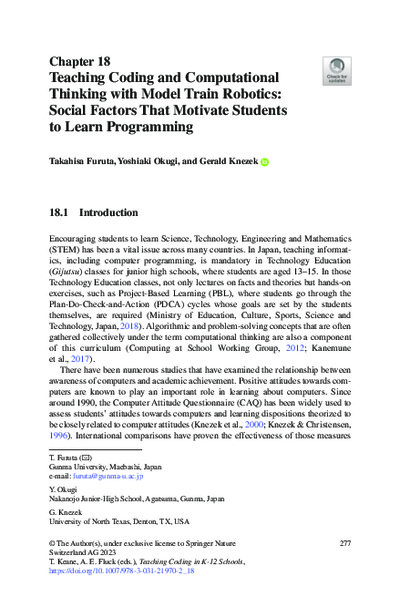Teaching Coding and Computational Thinking with Model Train RoboticsSocial Factors That Motivate Students to Learn Programming
|
 |
 Diese Seite wurde seit 2 Jahren inhaltlich nicht mehr aktualisiert.
Unter Umständen ist sie nicht mehr aktuell.
Diese Seite wurde seit 2 Jahren inhaltlich nicht mehr aktualisiert.
Unter Umständen ist sie nicht mehr aktuell.
 Zusammenfassungen
Zusammenfassungen
 Computer programming has become a vital topic in formal educational scenes especially in the last decade after the introduction of the concept of computational thinking. Computational thinking, or problem-solving activities that make the most of computing, is an integral part of the twenty-first-century skills, which include critical thinking, creativity, flexibility, leadership and social collaborative skills. Beginning in 2009, the authors started a project to teach programming through the process of writing code to control model trains. Though we began with a textual programming environment, as we analysed teaching and learning practices in junior high schools, we developed a visual block programming environment for teaching programming, initially because students were not very familiar with the keyboard. The block programming environment, however, had unexpected effects of motivating students, of both genders, whose power seemed to have come from the students’ collaborative interactions while working on their programs. We conducted a series of surveys and tested which socio-emotional factors best contributed to learning programming in the classroom environment, as assessed by end-of-class project and exam scores. This research was part of an ongoing action research agenda to find and refine the best ways to motivate students aged 12–15 to learn programming and computational thinking skills, which became required for all Japanese students by Ministry of Education guidelines adopted in 2018.
Computer programming has become a vital topic in formal educational scenes especially in the last decade after the introduction of the concept of computational thinking. Computational thinking, or problem-solving activities that make the most of computing, is an integral part of the twenty-first-century skills, which include critical thinking, creativity, flexibility, leadership and social collaborative skills. Beginning in 2009, the authors started a project to teach programming through the process of writing code to control model trains. Though we began with a textual programming environment, as we analysed teaching and learning practices in junior high schools, we developed a visual block programming environment for teaching programming, initially because students were not very familiar with the keyboard. The block programming environment, however, had unexpected effects of motivating students, of both genders, whose power seemed to have come from the students’ collaborative interactions while working on their programs. We conducted a series of surveys and tested which socio-emotional factors best contributed to learning programming in the classroom environment, as assessed by end-of-class project and exam scores. This research was part of an ongoing action research agenda to find and refine the best ways to motivate students aged 12–15 to learn programming and computational thinking skills, which became required for all Japanese students by Ministry of Education guidelines adopted in 2018. Dieses Kapitel erwähnt ...
Dieses Kapitel erwähnt ...
 Personen KB IB clear | Computing at School Working Group | ||||||||||||||||||
 Begriffe KB IB clear | Bildungeducation (Bildung)
, computational thinkingcomputational thinking
, Japan
,  Kreativität Kreativität creativity
, creativity
,  Lernen Lernen learning
, learning
,  MINT MINT science, technology, engineering, mathematics
, science, technology, engineering, mathematics
,  Programmieren Programmieren programming
, programming
,  Roboter Roboter robot
, robot
,  Schule Schule school school
| ||||||||||||||||||
 Texte |
|
 Dieses Kapitel erwähnt vermutlich nicht ...
Dieses Kapitel erwähnt vermutlich nicht ... 
 Nicht erwähnte Begriffe | Digitalisierung, Kinder, LehrerIn, Schweiz, Unterricht |
 Tagcloud
Tagcloud
 Zitationsgraph (Beta-Test mit vis.js)
Zitationsgraph (Beta-Test mit vis.js)
 Volltext dieses Dokuments
Volltext dieses Dokuments
 |  Teaching Coding and Computational Thinking with Model Train Robotics: Artikel als Volltext ( Teaching Coding and Computational Thinking with Model Train Robotics: Artikel als Volltext ( : :  , 382 kByte; , 382 kByte;  : :  ) ) |
 Anderswo suchen
Anderswo suchen 
 Beat und dieses Kapitel
Beat und dieses Kapitel
Beat hat Dieses Kapitel während seiner Zeit am Institut für Medien und Schule (IMS) ins Biblionetz aufgenommen. Er hat Dieses Kapitel einmalig erfasst und bisher nicht mehr bearbeitet. Beat besitzt kein physisches, aber ein digitales Exemplar. Eine digitale Version ist auf dem Internet verfügbar (s.o.). Es gibt bisher nur wenige Objekte im Biblionetz, die dieses Werk zitieren.









 Biblionetz-History
Biblionetz-History